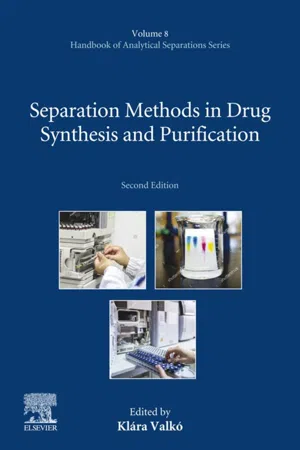
- 788 pages
- English
- ePUB (mobile friendly)
- Available on iOS & Android
Separation Methods in Drug Synthesis and Purification
About this book
Separation Methods in Drug Synthesis and Purification, Second Edition, Volume Eight, provides an updated on the analytical techniques used in drug synthesis and purification. Unlike other books on either separation science or drug synthesis, this volume combines the two to explain the basic principles and comparisons of each separation technique. New sections to this volume include enantiomer separation using capillary electrophoresis (CE) and capillary electro- chromatography, the computer simulation of chromatographic separation for accelerating method development, the application of chromatography and capillary electrophoresis used as surrogates for biological processes, and new developments in the established techniques of chromatography and preparative methods.- Features descriptions and applications of all separation methods used in the pharmaceutical industry- Written by the leading scientists in their respective fields, providing solutions for a wide range of industrial separation problems encountered within the pharmaceutical industry- Thoroughly updated with brand new separation science techniques and the latest developments in the established techniques of chromatography
Frequently asked questions
- Essential is ideal for learners and professionals who enjoy exploring a wide range of subjects. Access the Essential Library with 800,000+ trusted titles and best-sellers across business, personal growth, and the humanities. Includes unlimited reading time and Standard Read Aloud voice.
- Complete: Perfect for advanced learners and researchers needing full, unrestricted access. Unlock 1.4M+ books across hundreds of subjects, including academic and specialized titles. The Complete Plan also includes advanced features like Premium Read Aloud and Research Assistant.
Please note we cannot support devices running on iOS 13 and Android 7 or earlier. Learn more about using the app.
Information
Comparison of various modes and phase systems for analytical HPLC
Abstract
Keywords
1.1. Fundamentals of high-performance liquid chromatography
1.1.1. Characteristics of high-performance liquid chromatography separation
1.1.2. Elution development and chromatographic peaks
Table of contents
- Cover image
- Title page
- Table of Contents
- Contributors
- Chapter 1. Comparison of various modes and phase systems for analytical HPLC
- Chapter 2. Fast-generic HPLC methods
- Chapter 3. Advances in capillary electrochromatography
- Chapter 4. Coupled chromatography–mass spectrometry techniques for the analysis of combinatorial libraries
- Chapter 5. Experimental design-based optimization strategies for chromatographic and capillary electrophoretic separations
- Chapter 6. Computer-aided HPLC method development for quality control of complex drug mixtures – An application example for DryLab
- Chapter 7. The flexible application of automated preparative purification platforms within drug discovery
- Chapter 8. Strategies for the development of process chromatography as a unit operation for the pharmaceutical industry
- Chapter 9. Recent developments in liquid and supercritical fluid chromatographic enantioseparations
- Chapter 10. Basis and pharmaceutical applications of thin-layer chromatography
- Chapter 11. Recent advances in quantitative structure–retention relationships
- Chapter 12. Capillary electrophoresis for drug analysis and physicochemical characterization
- Chapter 13. Application of HPLC measurements for the determination of physicochemical and biomimetic properties to model in vivo drug distribution in support of early drug discovery
- Index